Illustration of the relationship between volume and price at each stage: price parity and volume increase. Price parity
and volume increase means that when trading volume increases, the stock price almost maintains fluctuations around the same price.
1. Increase in price parity and volume in the early stage of rise
(1) Pattern analysis
In the early stage of stock price rise, increase in price parity and volume is a healthy change of chips. This may be the main force accumulating funds at a low level or washing the market, and the market outlook is bullish.
(2) Operational suggestions:
Investors can buy at low prices
(3) Example analysis
As shown in the figure, the stock rose slightly from the bottom and then began to trade sideways. During this period, it went out of the form of price parity and volume increase. The main force had obvious intentions of lowering the price and washing the market. After that, the stock price continued to rise, and there was a wave of violent rises. Quotes.
Price parity and volume increase in the early stages of the rise
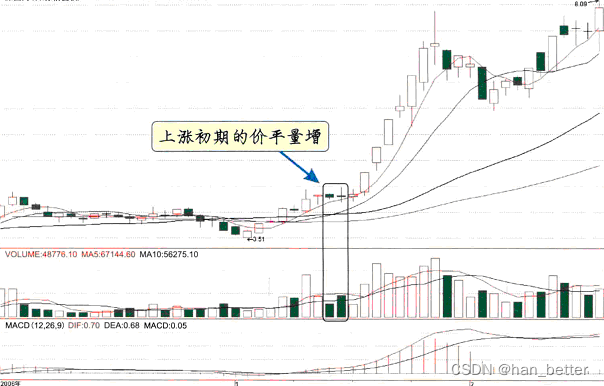
2. Increase in price parity and volume on the way up
(1) Pattern analysis
When the stock price rises, the pattern of increase in price parity and volume appears. On the one hand, it may be that the main force is lowering the price to attract funds; on the other hand, it may be profit taking during the session. More disks.
(2) Operation suggestions
1. If the increase is not large, you can still buy.
2. If the stock price rises significantly in the early stage, investors may consider building a position.
(3) Example analysis
As shown in the figure, the stock showed price parity and volume increase on the way up. The long upper shadow of the second small positive line indicated that the market was under heavy selling pressure and the rise was blocked. However, the heavy volume increase the next day showed that This is just a break on the way up.
Price parity and volume increase on the way up
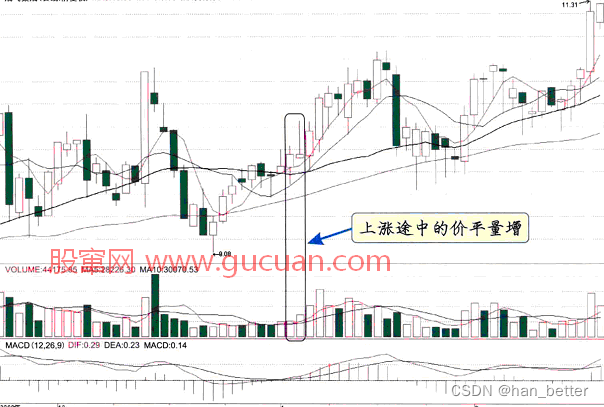
3. Price parity and volume increase at the end of the rise
(1) Pattern analysis:
After a sharp rise, the stock price trend slowed down and the price remained flat, but the trading volume continued to increase. This was mostly due to the main force shipping, and the market outlook may reverse at any time.
(2) Operational suggestions:
Investors should sell stocks
(3) Example analysis
As shown in the figure, after a long period of rise, the stock experienced stagflation at a high level. During this period, it formed a pattern of price parity and volume increase. The main force has obvious intention to ship, and investors should stay away and wait and see.
Price parity and volume increase at the end of the rise
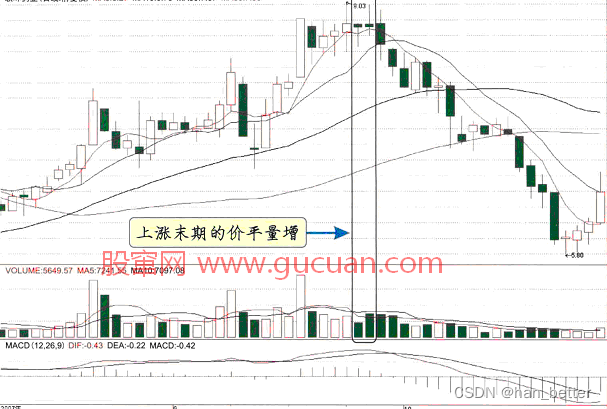
4. Increase in price parity and volume in the early stage of decline
(1) Pattern analysis
The pattern of increase in price parity and volume in the early stage of decline may be a consolidation pattern during the decline, and the market outlook is more likely to continue to decline.
(2) Operational suggestions:
Investors should stay away and wait and see
(3) Example analysis
As shown in the figure, the stock price showed stagflation after reaching a high level. After a slight decline, it showed price parity and volume increase. This may be caused by the main force fleeing, and investors should leave the market decisively.
Price parity and volume increase in the early stages of decline
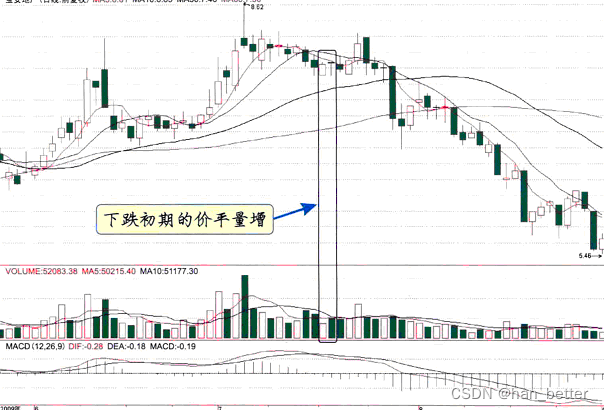
5. Increase in price parity and volume during the decline
(1) Pattern analysis
The increase in price parity and volume during the downward trend may be just a break during the decline, and the market outlook will continue to decline.
(2) Operational suggestions:
Investors should hold the currency and wait and see.
(3) Example analysis
As shown in the figure, the stock showed a pattern of price parity and volume increase during the decline, but later it was proved that this was just a relay of decline. The bulls had no intention of fighting at all, and the stock price will continue to fall.
Price parity and volume increase on the way down

6. Increase in price parity and volume at the end of the decline
(1) Pattern analysis
At the end of the downward trend, the pattern of increase in price parity and volume appears, indicating that the main force has intervened, and the market outlook is expected to stop the decline and stabilize or rebound.
(2) Operational suggestions:
Investors can pay close attention and be prepared to buy
(3) Example analysis
As shown in the figure, after the stock fell for a long time, the momentum of the short side gradually weakened. On one day, a long lower shadow cross line with a closing price that was the same as the previous day was closed. The trading volume was enlarged, indicating that the stock price was low. The ability to undertake business has begun to increase, and the market outlook is expected to stop falling and rebound.
Price parity and volume increase at the end of the decline
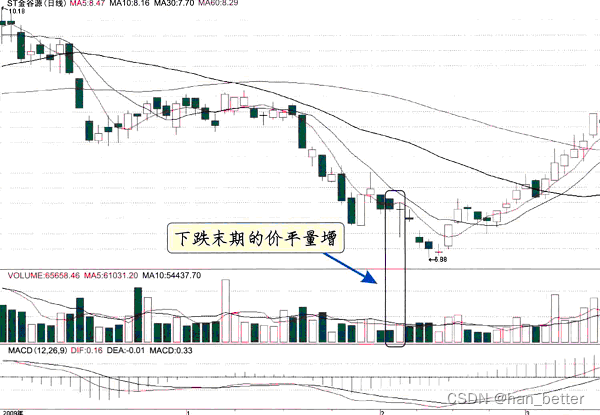
7. Increase in price parity and volume during the consolidation trend
(1) Pattern analysis:
Increase in price parity and volume during the consolidation trend indicates an increase in buying orders and a possible rise in the market outlook.
(2) Operational suggestions:
Investors can pay close attention and buy once the stock price breaks through the sideways area due to heavy volume.
(3) Example analysis
As shown in the figure, the stock moved sideways after a period of rising prices. During this period, a pattern of price parity and volume growth appeared, indicating that buyers actively intervened, and the market outlook is expected to rise again. Investors can wait for the stock price to break upward on heavy volume. Consolidate the high point of the platform before buying.
Pattern:
Price parity and volume increase in consolidation trend
